Article's Content
The global pandemic forced more than a few companies to pivot. With lockdowns in effect and customer behavior altered to unprecedented levels, it quickly became an adapt-or-perish scenario. So bakeries began selling home-baking kits, breweries churned out batches of hand sanitizer, and restaurant reservation platforms nudged into the grocery delivery space.
Hopin, which bills itself as the first virtual venue for live online events, would later appear prophetic because it launched a product in early 2019 that proved to be an ideal solution for many of the complexities the world would face in the coming months.
While the original business idea came along well before anyone discussed lockdowns, it was still born out of illness-induced isolation. Founder Johnny Boufarhat struggled with an autoimmune disease in 2015 that restricted him from leaving his London home. Desperate for a way to remain connected with others, he began working on a solution that would later serve thousands of clients who were facing the same dilemma on a massive scale.
The Hopin platform is designed to encourage networking and engagement from virtual event attendees. As a result, instead of sitting through boring business meetings while slumped over their keyboards, people can have memorable experiences.
As you’d expect, demand skyrocketed during the pandemic. After about a year in business, the Hopin platform had hosted 11,021 events in January 2020. Jump forward six months, and that number exceeded 32,000.
The hyper-speed growth that followed helped Boufarhat notch two impressive records:
- Hopin became the fastest-growing start-up ever seen in Europe
- Boufarhat became the youngest self-made billionaire in Britain
For Hopin, as with other COVID-era darlings like Zoom and Moderna, the pandemic provided more fuel for growth than obstacles. And Boufarhat is the first to admit that the pandemic played an advantageous role in his business prospects.
“I feel lucky,” he explained back in 2021. “You work really hard, and you make some critical decisions to get your business to where it is. But there’s also a really big part of luck that takes you there.”
But what goes up must come down. With the world transitioning into a post-pandemic phase and the term “Zoom fatigue” firmly entrenched in our lexicon, Hopin found itself unable to deliver relevant support for the overwhelming number of clients who were excited to return to in-person events.
The bakeries, breweries, and restaurant reservation platforms returned to their pre-COVID business models. Hopin, on the other hand, faced a crossroads.
Phase 1 of the Hopin Evolution
Once in-person events became possible, demand for virtual events began to wane. But Boufarhat’s team realized that not all employees eagerly lined up for in-person events. Some still felt uneasy in crowded places, while others may enjoy the idea of meeting people face to face but face health restrictions similar to those that limited Boufarhat prior to COVID.
To Hopin, hybrid events seemed like the future. Yet they found themselves leaning more into the virtual-based products they knew best.
Be warned: You should never underestimate the power of cabin fever. What Hopin’s clients actually wanted were tools to help them with events outside of the virtual realm. Research quoted on Hopin’s website reveals that “nearly 78% of event marketers stated they want in-person events to return to a primary role once it’s safe.”
To diversify their technology and provide more in-person tools to clients, Hopin went on a buying spree. Here are the six companies they acquired within seven months.
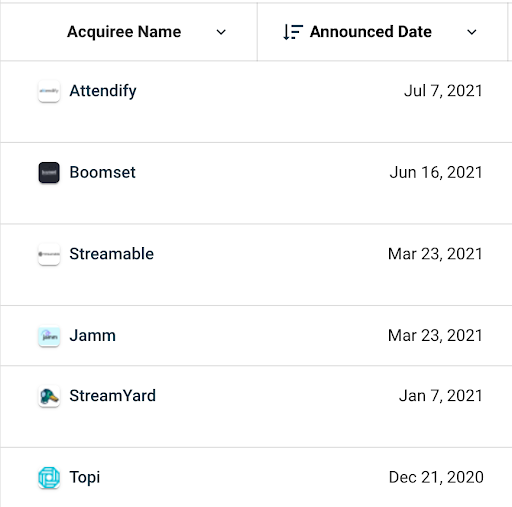
Hopin then unveiled a suite of products specifically for in-person events. Solutions included:
- Event landing page builder
- Event promotion tools
- Promo code creator
- Waitlist manager
- Payment processing
- Badge printing
Touting “best-in-class” onsite capabilities that would’ve seemed contradictory to Boufarhat’s vision back in 2015, the company was positioning itself for relevancy in 2022 and beyond.
Gaining Market Share Through Targeted Thought Leadership
Having things people want and convincing them that you’re the right source to buy them from are two very different things. Just ask your local RadioShack or Borders bookstore.
As Hopin moved into the in-person market, they ran into more established competitors who had no interest in making room for a plucky upstart. So how are they breaking through and gaining new clients? By asserting their industry leadership with targeted content. What Hopin lacks in tenure, they’re more than making up for in content and resources.
This approach certainly isn’t new, but I’ve noticed it being utilized with renewed vigor by young companies across many industries. Here are three primary reasons this strategy works:
- Modern clients want no-strings-attached value from businesses
- You can establish yourself as an industry leader by talking like one
- You’ll build trust with individuals who will later become clients
What makes Hopin’s efforts distinct is how effectively they’re targeting their messages. While many companies use a tool like Hootsuite to simultaneously post the same content on all their social media channels, Hopin ditches this shotgun approach for a more refined strategy.
Take this LinkedIn post, which didn’t appear on any of Hopin’s other main social channels:
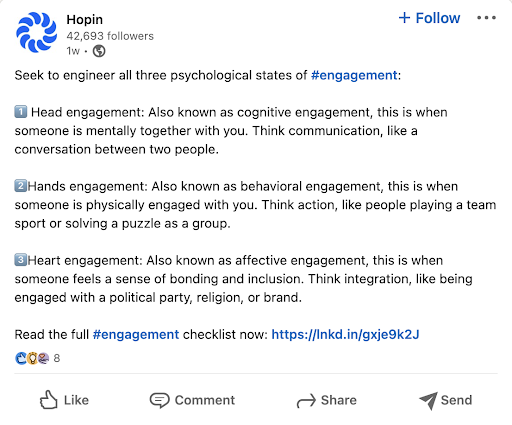
The post has academic elements, using psychological terms such as cognitive, behavioral, and affective engagement. The content suggests that Hopin’s LinkedIn audience is more professionally minded than on their other channels, and these followers respond well to actionable content packed with insights.
On Facebook, Hopin often posts helpful resources with a more accessible vibe. For example, this post features valuable content, but it’s packaged as “top event trends to have on your radar for 2022.”
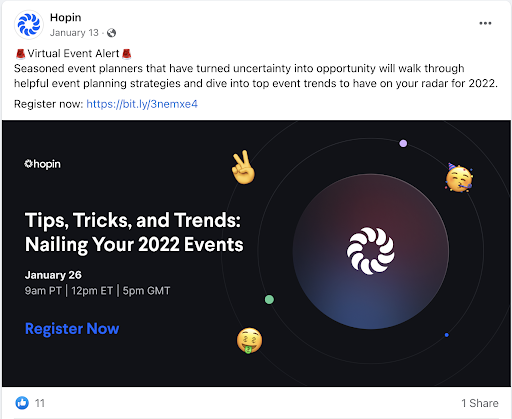
It’s easy to see the different tones they use to target their audiences on the two platforms. Hopin’s LinkedIn posts often use phrases like, “Seek to engineer all three psychological states of engagement,” while Facebook followers are treated to “Tips, Tricks, and Trends.”
Hopin’s X feed (formerly known as Twitter feed) is where their team has even more fun with the content, using slang and mixing in silly gifs. This post provides a playlist for company meetings, but instead of talking about psychological states, they throw in a fire emoji and refer to Rihanna as “RiRi.”
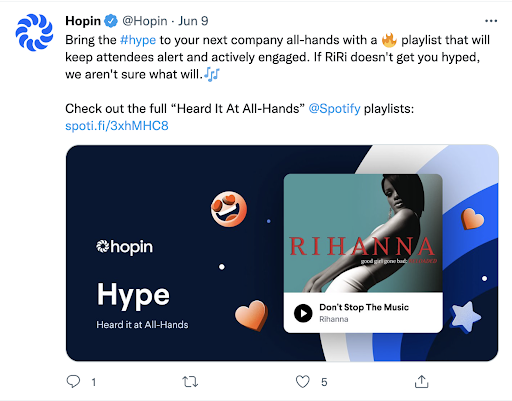
It’s fun and effective and allows them to deliver resources in a way that potentially resonates more with that specific audience.
LinkedIn is where Hopin has built their largest audience, with around 42,690 followers. But don’t assume that this proves their messaging strategy on LinkedIn is superior to what they’re doing on Facebook and X. They could also be getting strong results from those other platforms, just in more concentrated doses.
The Impact of Thought Leadership
Is it unique for a company to become an industry thought leader in only a couple of years? Not at all. A former colleague of mine named Rick actually showed me just how quickly one can become established as an expert.
An amateur cyclist who loved watching the Tour de France, Rick wanted to engage with the race on all three psychological levels that Hopin talks about. So he signed up as an expert source on Help a Report Out (HARO), a platform where journalists can find people to interview for articles. Rick also began posting race observations on his X account to create the appearance of being an official source of information.
Within a matter of weeks, Rick was being interviewed by outlets from around the globe. His words were initially limited to a paragraph or two within larger articles, but he ultimately ascended to the level where his live interviews were featured in video segments by the likes of CNN and BBC.
Hopin has similarly leveraged its energy and insights to position itself as a thought leader within the event space. It doesn’t matter that they’ve only been around since 2019 because they have solid ideas and communicate them in a way that connects with their unique audiences.
Check out their Semrush Authority Score, which has been climbing in recent months thanks to the company’s efforts to develop quality content, build referring links, and improve the quality of their inbound/outbound links.
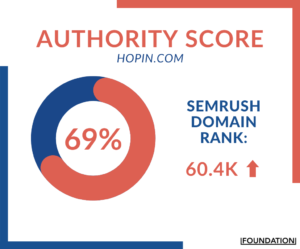
Speaking of Hopin’s website, let’s dig into the data to learn more about how their audience engages with their content. As you’ll see below, their monthly visits are on the rise, as are the number of unique visitors and how long those visitors are lingering.
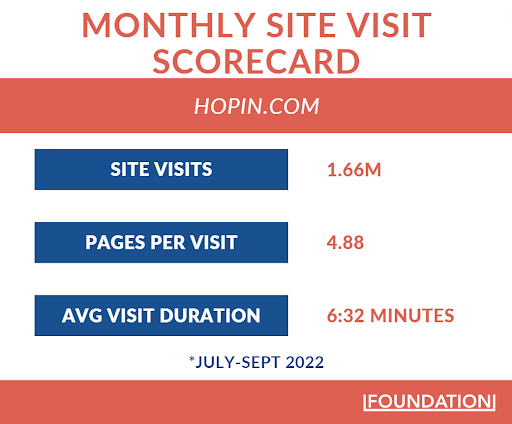
A general benchmark for determining a quality web experience is an average visit duration above 3 minutes — Hopin more than doubles that with a time of 6:32.
Although impressive, this is a significant reduction from their 12+ minute mark earlier in the year. Lots of factors influence how long visitors spend on a given website, but the rise in the percentage of mobile vs. desktop users is a likely contributor.
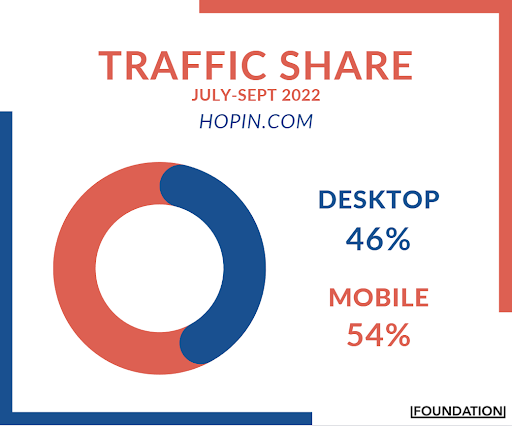
When most users view your content on a larger screen from the comfort of their office or couch, you have a real opportunity to get them to stay longer and engage deeper.
Hopin has doubled down on its website’s offerings by boosting both the quantity and quality of posts on its blog. An array of popular topics from within the event industry are covered. For example, this recent article shares strategies for connecting with leads after an event.

But you’ll never be viewed as a thought leader for simply covering the same industry topics (however relevant) as your competitors. So Hopin extends its influence by delving into industry challenges that often go unreported.
A prime example is Hopin’s ongoing series on mental health. Rather than preach to their audience, their blog team invites various professionals from outside the company to share their personal stories. The result is impactful and inspiring.
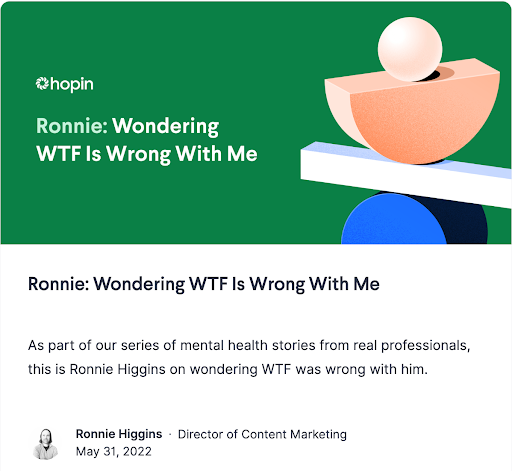
By offering this caliber of no-strings-attached value to professionals within their industry, Hopin is doing more than just keeping their clients on their website longer. They’re also achieving the name recognition and trustworthiness that brings new clients into the fold.
Check out the increase Hopin.com is experiencing in organic search traffic:
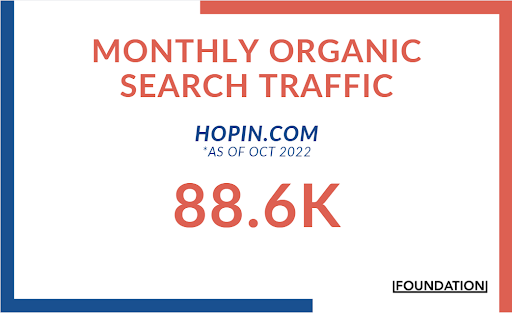
That stat is contextual when you look at their website performance over the past two years. Remember, Hopin launched in early 2020. So it took until September 2020 before their organic search traffic was substantial enough to begin registering with web tracking tools.
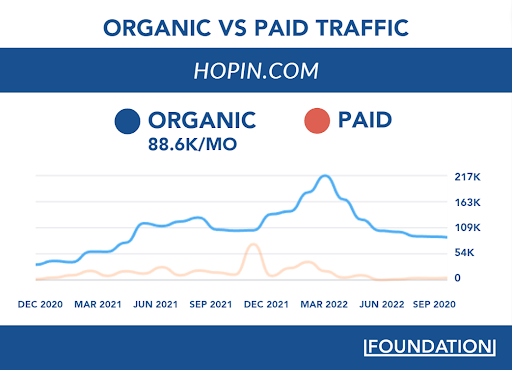
While Hopin’s strategy continues to drive positive numbers, they face headwinds. Their virtual solutions still have relevance but risk being drowned out by the unprecedented desire that many professionals have to get out of their homes and back to meeting and networking in person.
How Hopin Is Charting the Future
One of Hopin’s more successful tools during the pandemic was Hopin Explore, which allowed individuals to search a directory of virtual events open to anyone wanting to attend. It’s understandable why this tool was desirable during the lockdown, but it has now fallen out of favor with many users.
According to one report, the number of events went from 15,000+ in November 2020 to only 500 or so today.
Hopin has proven its ability to pivot, so moving resources away from the Explore platform was inevitable. They are now emphasizing solutions for private corporate events, which is why the company all-hands playlist they shared on X featuring RiRi fell squarely into the targeted priorities.
While these new strategies align with emerging business trends, their legacy products have stumbled enough that in February of this year, Hopin laid off 138 full-time employees (representing 12% of their staff at that time). Many observers labeled the move as yet another Peloton-like example of a company going all in on the peculiar needs created by the pandemic while ignoring that everyone else was already moving toward a post-COVID world.
But it’s hard to fault Hopin for this apparent myopia. Like Zoom, they were caught up in a tornado of demand that required nearly round-the-clock effort. Now that the proverbial dust is settling after the pandemic, Hopin has the luxury of forecasting and learning from their earlier mistakes. They’re developing quality content and establishing trustworthiness, which will help them immensely in the coming months and years.
And their collaborative approach to storytelling on their blog is another competitive advantage that shouldn’t be overlooked. This network of guest-writing professionals can provide insights and warnings regarding the industry’s evolution. It’s like having lookouts stationed around the world to help you stay more prepared for action.
They might be the new kids on the block when it comes to supporting in-person events, but Hopin is using content and quality to position itself for big success.







